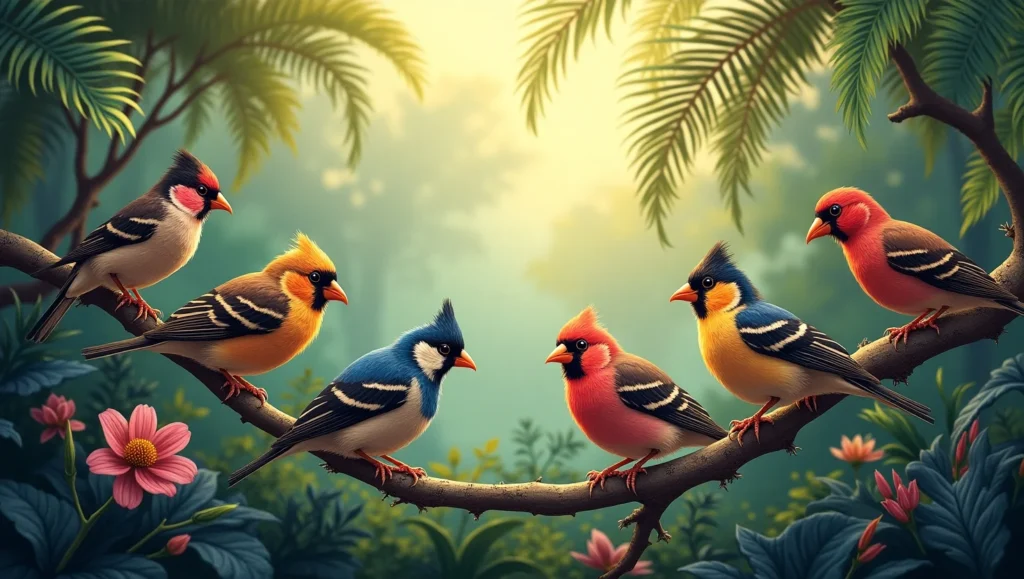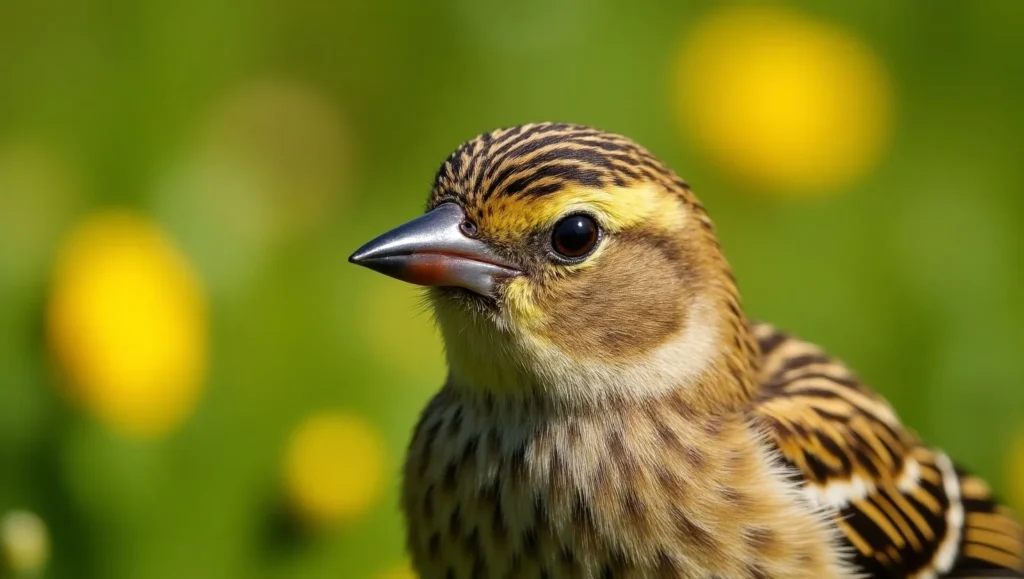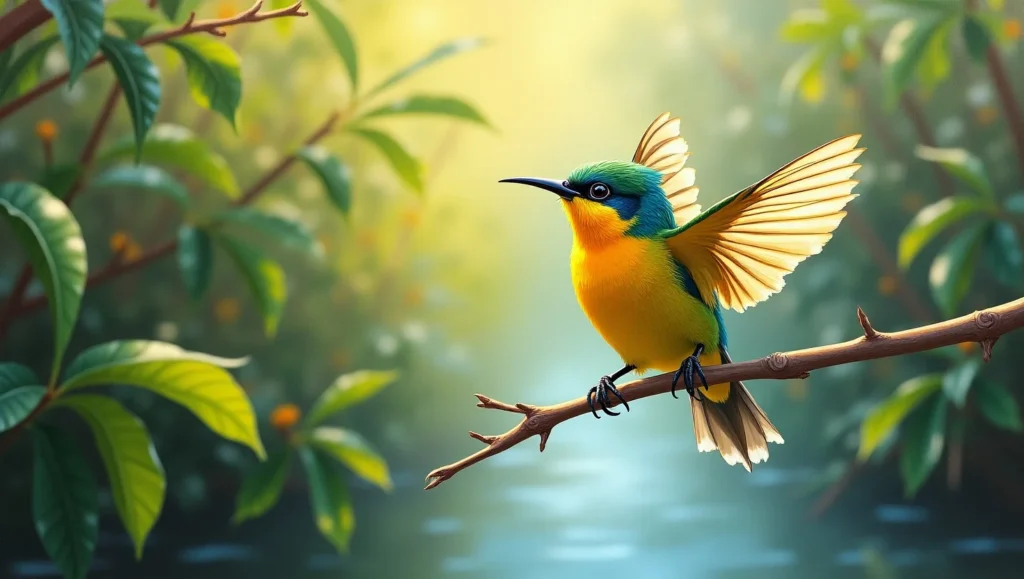Finches brighten Florida’s skies with their colorful feathers and cheerful songs. Explore vibrant finches in Florida, like House Finches, American Goldfinches, and Purple Finches, thriving in diverse habitats.
From backyards to wetlands, finches captivate birdwatchers and nature lovers. Here you will explore finches in Florida, their types, habitats, behaviors, and tips for attracting them.
Key Takeaways: Florida Finches
- Florida hosts colorful finches like House Finches, American Goldfinches, and Purple Finches.
- These birds thrive in gardens, forests, parks, wetlands, and suburban areas.
- House Finches are common year-round; Purple Finches and Pine Siskins visit in winter.
- Finches help in seed dispersal and play a role in Florida’s biodiversity.
- White finches are rare and result from genetic conditions like albinism or leucism.
- Conservation efforts include planting native species and supporting bird-friendly practices.
- Finches hold cultural value, symbolizing joy and freedom in Florida communities.
What Are the Most Common Finches in Florida?
Finches belong to the Fringillidae family. They are small, seed-eating birds with conical beaks. Their vibrant colors and melodic songs make them a favorite among bird enthusiasts.

In Florida, finches adapt to various environments, from urban gardens to rural forests. Their presence enhances the state’s biodiversity, making them a key part of its ecosystem.
Why Are Finches Special in Florida?
Florida’s warm climate and varied landscapes create ideal conditions for finches. The state’s mix of wetlands, forests, and suburban areas offers abundant food and nesting sites.
Finches contribute to seed dispersal, supporting plant growth.
Their adaptability to human environments also makes them a common sight in backyards.
Types of Finches in Florida:
Dozens of finch species brighten Florida’s landscapes. Each carries distinct features and habits. Below, we detail the most notable ones. This guide helps you spot them in your yard or nearby parks.
House Finch:
House finches in Florida are widespread. Males sport red or orange heads and chests. Females have streaky brown feathers. These birds love feeders filled with sunflower seeds. You’ll spot them in suburban areas or open woodlands. Their warbling songs echo in the mornings.
American Goldfinch:
American goldfinches dazzle onlookers bright yellow in summer and fade to olive in winter. These finches prefer open fields and gardens and snack on thistle seeds. Watch them flutter in small flocks. Their bouncy flight pattern is a giveaway.
Purple Finch:
Less common, purple finches visit Florida in winter. Males have raspberry-red heads and backs. Females show bold brown streaks. They favor coniferous forests but venture into backyards. Their rich songs carry a distinct melody. Look for them at feeders during colder months.
Pine Siskin:
Pine siskins appear in Florida during winter migrations. Their brown bodies show fine yellow streaks on their wings. These tiny birds love coniferous trees and weedy fields. Thistle feeders draw them in. Listen for their buzzy, chattering calls. They often mix with goldfinches.

Evening Grosbeak:
Rare in Florida, evening grosbeaks make winter comeos. Males glow yellow with black wings and white patches, while females are grayish with subtle yellow. They prefer pine forests but visit feeders. Sunflower seeds tempt them, and their sharp, whistling calls stand out.
Red Crossbill:
Red crossbills are uncommon but exciting finds. Males shine brick-red, while females are yellowish. Their crossed beaks crack pinecones with ease. Look for them in northern Florida’s pine forests. They rarely visit feeders. Their jip-jip calls echo through the trees.
White-winged Crossbill:
White-winged crossbills are elusive visitors. Males boast pinkish-red feathers; females are streaky yellow. Distinct white wing bars mark them. They stick to spruce and pine woods. Seeds from cones are their meal. Their thrilling songs carry far. Spot them in winter up north.
Lesser Goldfinch:
Lesser goldfinches occasionally roam South Florida. Males are black-backed with yellow underparts. Females look duller with olive tones. They favor open areas and scrublands. Nyjer seeds keep them happy. Their soft, tinkling calls blend into flocks.
Indigo Bunting:
Often mistaken for a finch, indigo buntings stun with blue plumage. Males glow vibrant blue in spring; females are plain brown. They thrive in shrubby edges and gardens. Seeds and insects fuel them. Their paired-note songs ring clear. Summer brings them out.
Painted Bunting:
Painted buntings, though not true finches, dazzle like them. Males mix blue heads, red bellies, and green backs. Females are greenish. They hide in thickets and coastal scrub. Feeders with millet attract them. Their warbled songs are soft. South Florida hosts them in summer.
Common Finches and Finch-Like Birds in Florida:
| Species | Colors/Markings | Preferred Habitat | Top Food Choice |
| House Finch | Red/orange (males), brown (females) | Suburbs, woodlands | Sunflower seeds |
| American Goldfinch | Yellow (summer), olive (winter) | Fields, gardens | Thistle seeds |
| Purple Finch | Raspberry-red (males), brown streaks | Forests, backyards | Mixed seeds |
| Pine Siskin | Brown with yellow wing streaks | Coniferous trees, fields | Thistle seeds |
| Evening Grosbeak | Yellow/black (males), gray (females) | Pine forests, feeders | Sunflower seeds |
| Red Crossbill | Brick-red (males), yellowish (females) | Pine forests | Pinecone seeds |
| White-winged Crossbill | Pinkish-red (males), yellow (females) | Spruce, pine woods | Cone seeds |
| Lesser Goldfinch | Black/yellow (males), olive (females) | Scrublands, open areas | Nyjer seeds |
| Indigo Bunting | Blue (males), brown (females) | Shrubby edges, gardens | Seeds, insects |
| Painted Bunting | Blue/red/green (males), green (females) | Thickets, coastal scrub | Millet |
Where to Find Finches in Florida?
Finches add color and song to Florida’s landscapes. These small birds, like House Finches, American Goldfinches, and Purple Finches, live in many places across the state. Whether you’re new to birdwatching or a fan, this guide shares the best spots to see finches using simple words. Let’s explore where to find them!
City and Suburb Spots:
Parks in cities attract House Finches. Visit Miami’s Crandon Park or Orlando’s Lake Eola Park. These birds perch in trees or near feeders. Suburbs in Tampa or Jacksonville also have them in backyards. Look for red-headed males in bushes. Early mornings are best for spotting them.
Gardens draw American Goldfinches. Check Naples Botanical Garden for sunflowers, which they love. Golf courses in Palm Beach have open fields where Goldfinches feed. Scan grass or low plants for their yellow feathers. Bring binoculars to see them.
Nature Areas:
Everglades National Park hosts Goldfinches. They eat seeds in wetlands. Walk the Anhinga Trail in spring to see them fly. Listen for their high chirps. Stay patient, as the park is big.
Ocala National Forest hides Purple Finches in winter. These birds like thick woods. Try the Yearling Trail in January. Their red heads stand out. Walk quietly to avoid scaring them.
Paynes Prairie Preserve State Park near Gainesville pulls in Goldfinches. Its fields have wildflowers that they eat. The La Chua Trail is great for morning visits. Look for flocks in tall grass.
Coastal Spots:
Beaches like Fort De Soto Park in St. Petersburg bring House Finches. They feed in low shrubs. Check picnic areas at sunrise. Their brown or red feathers are easy to spot.
J.N. “Ding” Darling Refuge on Sanibel Island has Goldfinches and House Finches. Walk the Indigo Trail or drive the Wildlife Drive. Use binoculars for quick movers. Late spring shows the most birds.
Best Times for Birdwatching:
Mornings from 6 to 9 a.m. are prime for finches. Spring (March to May) shows bright colors. Summer keeps House Finches busy. Winter (December to February) brings Purple Finches. Skip hot afternoons when birds hide. Cloudy days help you see more.
Behaviors and Characteristics of Florida Finches:
Finches primarily eat seeds, berries, and insects. Their conical beaks crack open tough seed shells. American Goldfinches love Nyjer seeds, while House Finches enjoy sunflower seeds. In summer, they may eat small insects to supplement their diet. Providing varied feeders can attract them to your yard.

Females lay 3-6 eggs, which hatch in about two weeks. Both parents feed the chicks, ensuring their survival. Breeding season peaks in spring and summer, aligning with abundant food sources.
They are social birds. They gather in flocks, especially in winter, to forage together. Their songs and calls strengthen group bonds. House Finches, for instance, sing complex melodies to attract mates. Observing their interactions offers insight into their lively nature.
White Finches in Florida – The Rare Species:
White finches, as a distinct species, are not commonly found in Florida. The term “white finch” often refers to rare color variations or albino individuals of common finch species, such as the House Finch or American Goldfinch.
These birds, typically known for their vibrant reds or yellows, can occasionally appear white due to genetic mutations like albinism or leucism. Below, we explore the presence of these unique birds in Florida, their characteristics, habitats, and how to spot them, using simple words and addressing the challenges they face.
True white finches are rare in Florida. Most finches in the state, like House Finches or American Goldfinches, have colorful feathers. However, some finches may look white because of special conditions.
Albinism makes birds fully white with pink eyes, while leucism causes partial white patches. These traits happen due to gene changes and are not common. Spotting a white finch in Florida is a special treat for birdwatchers.
Conservation and Challenges for florida finches and sparrows:
Keeping finches safe in Florida means knowing their problems. Cities growing bigger destroy their homes. Trees and wetlands disappear, leaving fewer places for finches like the American Goldfinch to live and eat. This pushes them into tiny areas where surviving is tough.
Weather changes make things harder. Hotter days and strange seasons mess up when finches travel. Purple Finches need steady weather to fly through Florida. Bad weather also hurts plants, so there are fewer seeds for food. These changes make life tricky for finches.
Danger from animals is a big issue, especially in towns. Cats and hawks hunt finches near houses and feeders. House Finches in neighborhoods get attacked more often. Windows also hurt finches because they fly into glass by mistake. These dangers lower their numbers.
People are working to help finches. Groups like the Florida Audubon Society plant trees and bushes to make safe spots. They teach folks how to protect birds, like putting stickers on windows to stop crashes. Helpers also watch finches to see if they’re doing okay.
You can help finches, too. Grow plants like sunflowers to give them food and homes. Skip using bug sprays that harm finches. Give money or time to groups that save bird homes. Every little step keeps finches singing in Florida’s skies.
Cultural Significance:
Finches symbolize joy and freedom in many cultures. In Florida, their presence in gardens and parks uplifts communities. Birdwatching events, like the Great Backyard Bird Count, celebrate their role in connecting people with nature.
These small birds, like the American Goldfinch, House Finch, and Purple Finch, do more than just decorate the state’s landscapes. They inspire communities, connect people to nature, and symbolize joy across the Sunshine State.
Using simple words, this section explores how finches shape Florida’s traditions, events, and everyday life, while highlighting their importance to residents and visitors.
How to Attract Finches to Your Florida Backyard?
Attracting finches starts with the right feeder. Tube feeders with small ports suit their size. Mesh socks work well for Nyjer seeds. Place feeders in open areas, away from predators like cats. Clean feeders regularly to prevent disease. Offer these foods to entice finches:
- Nyjer Seeds: A favorite of American Goldfinches.
- Sunflower Seeds: Loved by House Finches.
- Millet: Attracts a variety of finches.
Mix seeds to cater to different species. Fresh water sources also draw finches for drinking and bathing. Plant native shrubs and flowers to provide natural food and shelter. Examples include:
- Sunflowers: Seeds attract Goldfinches.
- Coneflowers: Offer seeds and perching spots.
- Dogwood Trees: Provide berries and nesting sites.
Avoid pesticides, as they harm finches and their food sources. A birdbath adds appeal, encouraging finches to linger.
FAQs:
What does a Florida finch look like?
Florida finches, like House Finches, have reddish heads (males) or brown streaks (females). American Goldfinches are bright yellow in summer, turning dull brown in winter. Purple Finches show raspberry-red heads. All are small with short, conical beaks.
When should I put out my finch feeders?
Set up finch feeders in early spring (March) to catch the breeding season. Keep them out year-round, as House Finches stay all year and Purple Finches visit in winter (December to February).
How do you tell if a bird is a finch?
Look for a small bird with a thick, cone-shaped beak for cracking seeds. Finches often have colorful feathers (red, yellow, or brown) and sing cheerful, warbling songs. They gather in flocks and love feeders.
What is the small sparrow-like bird in Florida?
The House Finch is a common sparrow-like bird in Florida. It’s small, brown (females) or red-headed (males), and often seen in yards or parks. Sparrows are similar but have thinner beaks.
Conclusion:
Finches bring color and song to Florida’s landscapes. Their adaptability and charm make them a treasure for birdwatchers and residents. By understanding their habits, habitats, and needs, you can attract them to your backyard and support their conservation.
Whether you’re a seasoned birder or a curious beginner, exploring finches in Florida offers endless rewards. Grab your binoculars, set up a feeder, and join the adventure of discovering these delightful birds!
Read More:
- Must Read: Cardinals Appear When Angels Are Near!
- Must Read: 20 Types of Hawks in Wisconsin & How to Identify!
- Must Read: Top 10 Mythical Birds and Creatures!
